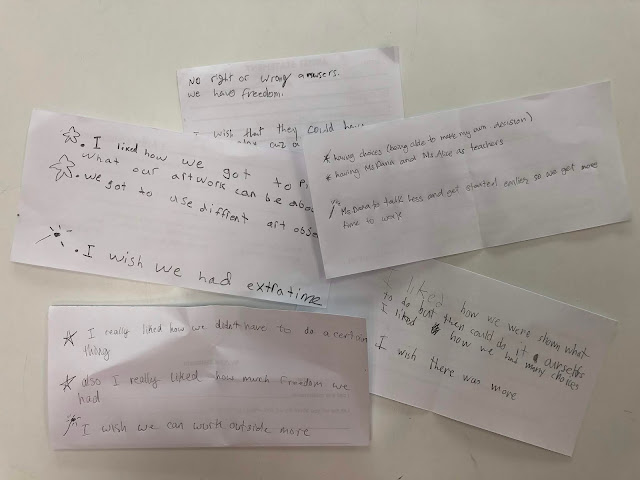Emergent Curriculum and Inquiry in the Art Room: Common Sense Teaching
When I first started teaching using the PYP framework, I didn't really know what I was getting into. I was fortunate enough to be hired by a school who was willing to take a teacher with no experience in the PYP, support me with professional development and mentors, and surround me with knowledgeable colleagues to observe and learn from.
I would say one of the best, but least talked about, advantages of teaching art using the PYP framework is the ability to focus on the emergent curriculum. "Emergent curriculum is based on the premise that children are most successful at learning when curriculum experiences account for their interests, strengths, needs, and lived realities. In emergent curriculum, both adults and children have initiative and make decisions. This power to impact curriculum decisions and directions means that sometimes curriculum is also negotiated between what interests children and what adults know is necessary for children’s education and development." (Emergent, 2017) This is not to say that all PYP art teachers are using emergent curriculum or that in order to use the emergent curriculum for teaching, you must use the PYP framework. But I have found it to be an instrumental part of my current teaching practice.
For me, the best part of switching to a student-centered, choice-based art studio is that the kids are leading what direction we go in. I have an idea of skills, concepts and attitudes that might be incorporated into a Unit of Inquiry, but they are quite broad and can be implemented in a variety of ways by students. The nature of the emergent curriculum is that you can only plan so much before waiting to see how the students respond before planning more. This has made a world of difference to my teaching practice and has made me more aware and observant of my students, what they are saying and doing, and how I need to adjust materials, emphasize Learner Profile attributes, encourage stages of the Creative Cycle, or provide opportunities for different skills. I have become MUCH more flexible and my mind is opening to new possibilities that students suggest for learning and creating along the way. I stress less about changing the plan, and honestly, I spend less time prior to a lesson preparing for it...most of the learning and planning is happening in the moment, with students' input.
Here is a screenshot of my lesson plan for the week, which applies to all classes, G1-G5. It is the same for all grades on paper, but in practice there are large differences in how students interpret, think and create based on these learning intentions. Depending on how they discuss, collaborate, create and respond to this lesson, I will plan the next week's lesson. Yes, I refer to my Yearly Overview to make sure we are hitting the concepts and skills necessary, but there are a lot of ways to do that.
I love that I'm not sure where the unit will take us. I love that student suggestions are genuinely taken into consideration. I love that I am not wasting my time planning "activities" or even knowing what the end products of student learning will look like. Students are happier and so am I.
Sources:
Emergent Curriculum. (2017). Retrieved from: http://elc.utoronto.ca/about-us/emergent-curriculum/
Douglas, K.A. (2009). Engaging Learners Through Artmaking: Choice-Based Art Education in the Classroom. New York, NY: Teachers College Press.
I would say one of the best, but least talked about, advantages of teaching art using the PYP framework is the ability to focus on the emergent curriculum. "Emergent curriculum is based on the premise that children are most successful at learning when curriculum experiences account for their interests, strengths, needs, and lived realities. In emergent curriculum, both adults and children have initiative and make decisions. This power to impact curriculum decisions and directions means that sometimes curriculum is also negotiated between what interests children and what adults know is necessary for children’s education and development." (Emergent, 2017) This is not to say that all PYP art teachers are using emergent curriculum or that in order to use the emergent curriculum for teaching, you must use the PYP framework. But I have found it to be an instrumental part of my current teaching practice.
For me, the best part of switching to a student-centered, choice-based art studio is that the kids are leading what direction we go in. I have an idea of skills, concepts and attitudes that might be incorporated into a Unit of Inquiry, but they are quite broad and can be implemented in a variety of ways by students. The nature of the emergent curriculum is that you can only plan so much before waiting to see how the students respond before planning more. This has made a world of difference to my teaching practice and has made me more aware and observant of my students, what they are saying and doing, and how I need to adjust materials, emphasize Learner Profile attributes, encourage stages of the Creative Cycle, or provide opportunities for different skills. I have become MUCH more flexible and my mind is opening to new possibilities that students suggest for learning and creating along the way. I stress less about changing the plan, and honestly, I spend less time prior to a lesson preparing for it...most of the learning and planning is happening in the moment, with students' input.
I love that I'm not sure where the unit will take us. I love that student suggestions are genuinely taken into consideration. I love that I am not wasting my time planning "activities" or even knowing what the end products of student learning will look like. Students are happier and so am I.
Sources:
Emergent Curriculum. (2017). Retrieved from: http://elc.utoronto.ca/about-us/emergent-curriculum/
Douglas, K.A. (2009). Engaging Learners Through Artmaking: Choice-Based Art Education in the Classroom. New York, NY: Teachers College Press.



Comments
Post a Comment